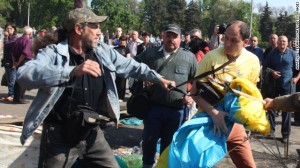Exploring Ukraine’s crisis, and its fateful decision in 1994

BOILING OVER: Tensions keep escalating in Ukraine, where a fateful decision made by Ukrainian officials in 1994 looms large.
By Rob Nikolewski │ New Mexico Watchdog
There’s an old, unfortunate adage, which is all too often repeated when it comes to the Middle East.
It can always get worse.
Sadly, Ukrainians are learning the phrase applies to them.
In the space of two months, they’ve seen Russia’s Vladimir Putin — acting like a bully shaking down a kid in a schoolyard for his lunch money — grab the Crimean Peninsula.
Losing its warm-water port was bad enough. But now, Ukraine’s very existence is in doubt. The mayor of an eastern Ukrainian city recently was shot in the back and critically wounded as pro-Russian forces threaten to swallow large chunks of the country, if not the entire thing.
An old Cold War truth is merging with today’s cold, hard truth: A belligerent Russia may well succeed in annexing Ukraine.
It’s clear that words won’t deter Putin, who is determined to take back territory lost after the Soviet Union collapsed 23 years ago.
And what’s happening in Ukraine is putting leaders on edge in countries with large Russian-speaking minorities — such as Georgia, Moldova and Estonia.
Estonia is crucial because it’s a member of NATO, and Article 5 of the NATO agreement stipulates an attack on one member is an attack on all members.
Another cold truth? Don’t count on the U.S. and western European nations going there.
Nobody’s talking about NATO or American boots on the ground in Eastern Europe, but the Obama White House has been slow on the uptake since this crisis began.
It still has not offered to share military intelligence with Ukraine and repeatedly has said it would not supply the Ukrainians light military weaponry in the face of a potential Russian assault. The Russians have an estimated 40,000 to 50,000 troops lined up on Ukraine’s border.
Instead, the administration hopes that economic sanctions do the trick.
Yet President Obama still has not countered Putin by hitting the Russian economy where it would hurt the most, in its energy sector. A threat of exporting liquefied natural gas to Europe could well compel Putin to at least think twice about the economic wisdom of intrusion.
Secretary of State John Kerry has called on Europe to end its dependence on Russian oil and gas but didn’t offer specifics.
But the Obama administration looks like a zealot compared to European leaders.
Fearful of Russia shutting off its oil and gas supplies, it took unmistakable signs of aggression — such as pro-Russian taking European monitors hostage — to get EU leaders to find some spine.
Near the end of World War II, upon being asked about Catholics in Poland, Josef Stalin famously asked. “How many divisions does the Pope have?” In 2014, Europe may have NATO divisions at its disposal, but if Putin reckons they’ll never be used, he has no reason not to take whatever he wants.
In these existential times for Ukraine, one can only imagine the enormous regret its people must have looking back at 1994.
That year, in the optimism of a post-Cold War world, Ukrainian leaders went to Budapest for an international meeting. Under the Soviet regime, nuclear missiles were still deployed in Ukraine. The U.S. and western European urged Ukraine to allow those missiles to be dismantled. The Ukrainians agreed after getting assurances that their borders would never be violated and would be defended if they were.
So much for that promise.
But a sobering geopolitical lesson may extend beyond Ukraine.
In a post-post-Cold War world, leaders in vulnerable countries may very well conclude — with logic that’s hard to argue with — that having their own nuclear arsenal equals protection.
That figures to make the world a much more combustible — and deadly — place.
Contact Rob Nikolewski at rnikolewski@watchdog.org and follow him on Twitter @robnikolewski







